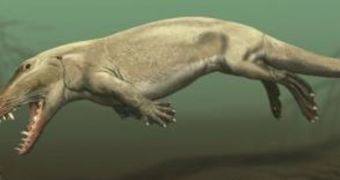Scientific knowledge on how the cetaceans, a group of aquatic mammals including whales, dolphins and porpoises, evolved is fairly scarce. Fossils belonging to the earliest such animals that decided to leave the ground and go into the water are very rare to come by, so the understanding of how these animals evolved has remained limited until recently. Currently, the largest, most massive data set of the morphology, behavior, and genetics of living and fossil relatives in this group is being used to answer some of the questions related to the evolution of the cetaceans.
One of such question is whether the animals that would go into the water first changed their diet – from being herbivorous to carnivorous –, or if they first lost their ability to walk and began to swim. According to the latest scientific paper on the theme, published in this week's issue of the Public Library of Science's journal PLoS ONE, it may be that the ancestors moved into the water before turning their diets around. Experts behind the paper give some arguments to support this, including the similarities that exist between the 48-million-year-old, semi-aquatic herbivore Indohyus and hippos.
“If you only had living taxa to figure out relationships within this group of animals, you would miss a large amount of diversity and part of the picture of what is going on. Indohyus is interesting because this fossil combines an herbivore's dentition with adaptations such as ear bones that are adapted for hearing under water and are traditionally associated with whales only,” American Museum of Natural History-affiliated graduate student Michelle Spaulding, who has also been the lead author of the recent journal entry, says, ScienceDaily reports.
“How do you put flesh and movement onto a fossil? The earliest stem whale probably ate prey in water while still being able to walk on land. Indohyus has some adaptations for hearing under water but also ate plants, while Ambulocetus (a walking whale that lived about 50 million years ago) seems to have been carnivorous,” Stony Brook University expert Maureen O'Leary, the author of another related study on the issue, adds.
“There is deep conflict in the evolutionary tree. The backbone of the tree is robust and stable, but you have these fairly large clades that move around relative to this backbone (Indohyus and mesonychids) We need to really re-examine characters carefully and see what suite of traits are the truly derived in different taxa to fully resolve this tree,” Spaulding shares. All the authors were supported through three separate research grants from the US National Science Foundation (NSF).

 14 DAY TRIAL //
14 DAY TRIAL //